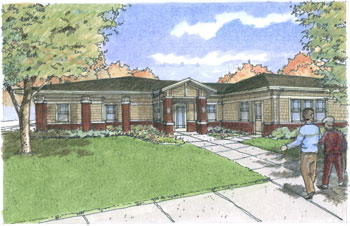 |
An artist’s rendering of the Weigel Williamson Center for Visual Rehabilitation. A groundbreaking for the new center will be today and UNMC officials say it should open next spring. |
The $1.2 million Weigel Williamson Center for Visual Rehabilitation will provide a hub for low-vision services in the region. Optometrists, ophthalmologists, occupational therapists and nurses would be members of the team of providers for low vision services at the facility.
“This center will provide a means to assist people who have low vision to gain — or regain — their independence and quality of life,” UNMC Chancellor Harold M. Maurer, M.D., said. “The Weigel Williamson Center will be a state-of-the-art facility in which our faculty, staff and other low-vision specialists will have the necessary resources to provide outstanding services for the people affected by low vision.”
Dr. Maurer lauded the donors who are making the facility possible. The center’s lead gift was made by Dr. Harry and Beth Weigel of Auburn, Calif., and Robert and Alice Williamson of Omaha to the University of Nebraska Foundation. Dr. Harry Weigel (pronounced WHY-gull) is a 1958 graduate of the UNMC College of Medicine.
In addition to the Weigels and Williamsons, the principal benefactors for the center include Gerald Christensen, M.D., and Mary Haven; Fred and Dakota Sturges; and the Adah and Leon Millard Foundation.
The benefactors will be recognized at today’s 10:30 a.m. ceremony at UNMC. The groundbreaking will be directly south of the Ronald McDonald House on the southwest corner of 38th Avenue and Jones Street. In addition to Dr. Maurer, ceremony speakers will include James B. Milliken, president of the University of Nebraska; Terry Fairfield, chief executive officer of the University of Nebraska Foundation; John Gollan, M.D., Ph.D., dean of the UNMC College of Medicine; Dr. Christensen, adjunct professor of ophthalmology and visual sciences and interim director of the UNMC Low Vision House; Carl Camras, M.D. chairman of the UNMC Department of Ophthalmology and Visual Sciences; Peter Whitted, M.D., an Omaha ophthalmologist in private practice; and Frank Velinsky, a local businessman who is a low-vision services patient.
|
|
When a patient’s vision can no longer be helped with glasses, contact lenses, medications, laser or surgery, his or her ophthalmologist can still offer hope, Dr. Camras said, by referring the patient for low vision rehabilitation services. “These services represent valuable aids for Nebraskans who are losing their independence and quality of life as the result of profound visual loss,” he said.
The 4,540 gross-square-foot, single story building with residential characteristics will model the renowned Deicke Center for Visual Rehabilitation in Wheaton, Ill. That center annually helps more than 1,300 children and adults maximize use of their remaining sight and learn to cope with the challenges of living with vision loss.
The state-of-the-art center also will include offices and support facilities for staff, exam rooms, interview/counseling and testing/training rooms, a room equipped with assistive technology, and a low vision store where devices will be available for clients to use before deciding whether to purchase them. Other spaces will include a low vision adapted kitchen, bath area, conference room, classroom and play area.
Optometrists, ophthalmologists, occupational therapists and nurses will be members of the team of providers for low vision services at the house.
Nearly 14 million Americans — about one out of every 20 people — have impaired vision. According to Lighthouse, Inc., New York, the older visually impaired population is the third-fastest growing group of people needing rehabilitation services in the United States, outpaced only by arthritis and heart disease. The most common conditions causing visual impairment are macular degeneration, glaucoma, diabetic retinopathy, stroke and a variety of hereditary diseases such as retinitis pigmentosa.
The center’s completion is scheduled for spring of 2008.